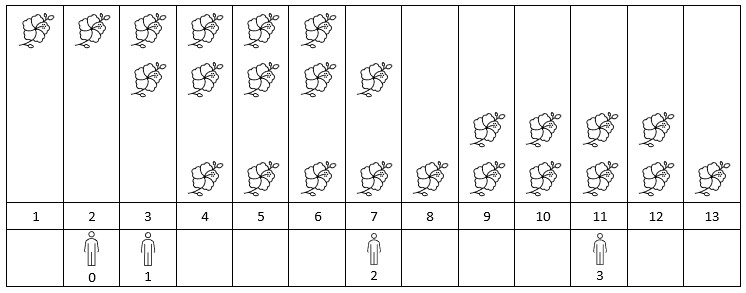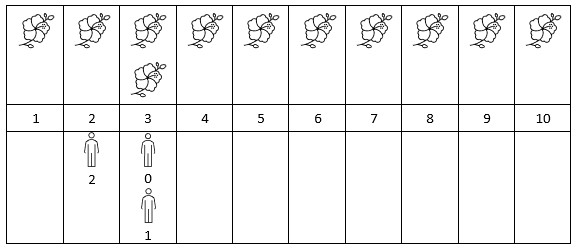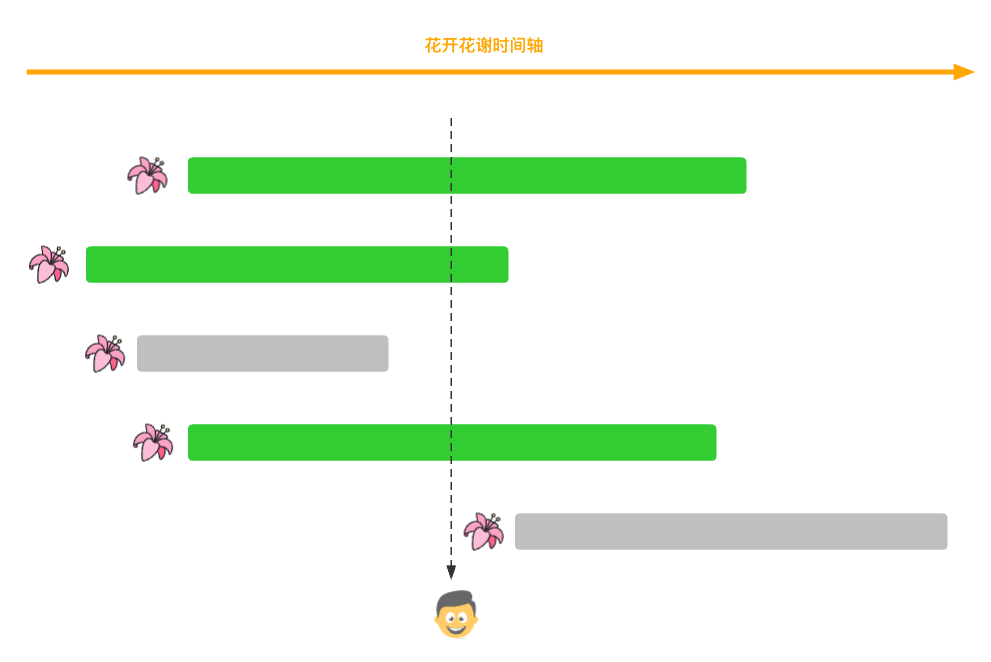![]()
2251. 花期内花的数目(看官方题解, 已解)
难度: 困难
来源: 每日一题 2023.09.28
给你一个下标从 0 开始的二维整数数组 flowers ,其中 flowers[i] = [starti, endi] 表示第 i 朵花的 花期 从 starti 到 endi (都 包含)。同时给你一个下标从 0 开始大小为 n 的整数数组 people ,people[i] 是第 i 个人来看花的时间。
请你返回一个大小为 n 的整数数组 answer ,其中 answer[i] 是第 i 个人到达时在花期内花的 数目 。
示例 1:

输入:flowers = [[1,6],[3,7],[9,12],[4,13]], people = [2,3,7,11]
输出:[1,2,2,2]
解释:上图展示了每朵花的花期时间,和每个人的到达时间。
对每个人,我们返回他们到达时在花期内花的数目。
示例 2:

输入:flowers = [[1,10],[3,3]], people = [3,3,2]
输出:[2,2,1]
解释:上图展示了每朵花的花期时间,和每个人的到达时间。
对每个人,我们返回他们到达时在花期内花的数目。
提示:
- 1 <=
flowers.length<= 5 * $10^4$ flowers[i].length == 2- 1 <= $start_i$ <= $end_i$ <= $10^9$
- 1 <=
people.length<= 5 * $10^4$ - 1 <=
people[i]<= $10^9$
class Solution {
public int[] fullBloomFlowers(int[][] flowers, int[] persons) {
}
}
分析与题解
-
HashMap缓存 结果: 思路错误, 时间超时, 运行失败 GG
当看这个这个题目的元素量级之后, 我就知道, 如果双层循环暴力方案一定会超时失败, 所以我就在想如何减少运行时间, 我首先想到的就是HashMap.
思路是这样, 当处于某一个人
people[i]看花时间, 如果先前没有缓存, 我们就缓存当前时间所有开放花的个数, 这样下一次某一个的看花时间 与people[i]看花时间相同, 我们直接从缓存中取出答案即可.int time = people[i]; if(cache.get(time) != null) { result[i] = cache.get(time); continue; } int count = 0; for(int j = 0; j < flowers.length; j++) { if(flowers[j][0] <= time && flowers[j][1] >= time) { count++; } } cache.put(time, count); result[i] = count;但是这样, 时间复杂度由于for的双层嵌套导致复杂度过高, 从而导致了超时失败.
整体逻辑代码如下所示.
class Solution { public int[] fullBloomFlowers(int[][] flowers, int[] people) { // 暴力法一般会导致超时 // 解决方案: 时间复杂度降维 // 当某个时间点来人之后, 我们就把当前时间节点的开花数目添加缓存中 Map<Integer, Integer> cache = new HashMap<Integer, Integer>(); int[] result = new int[people.length]; for(int i = 0; i < people.length; i++) { int time = people[i]; if(cache.get(time) != null) { result[i] = cache.get(time); continue; } int count = 0; for(int j = 0; j < flowers.length; j++) { if(flowers[j][0] <= time && flowers[j][1] >= time) { count++; } } cache.put(time, count); result[i] = count; } return result; } }复杂度分析:
- 时间复杂度: O(nm),
n与people的数组长度成线性关系,m与flowers的长度成线性关系. - 空间复杂度: O(n),
n与people的数组长度成线性关系.
结果如下所示.
结果: 思路错误, 时间超时, 运行失败 GG
- 时间复杂度: O(nm),
-
官方解法:二分法 结果: 成功
对于一个
people[i]来说, 我当时的考虑是它是一个时间点, 而每一朵花的花期是一个时间区间, 当时在想如何降维处理, 就是对于people[i]如何不通过遍历花期数组, 找到符合要求的花. 也就是把时间复杂度将至O(n)而不是O(nm).这样显然是不可行的. 那么官方是怎么做的呢? 官方有两种方式, 一种是查分, 一种是二分法, 这里我现在使用二分法.
首先, 我们看一下二分法的实现思路.
对于一个
people[i]来说, 如果我们知道, 有x朵在people[i]时间点之前开花, 有y朵在people[i]时间点之前谢花. 我们就知道在people[i]时间点还未花谢的有x - y朵花, 如图所示.首先, 谢花时间点一定在开花之后; 在某一个
people[i]时间点之前就花谢, 那一定看不到这个花(图中第三朵花); 在某一个people[i]时间点之后就花开, 那也一定看不到这个花(图中第五朵花);所以这个人能看到
4 - 1 = 3朵花.
如果我们没有排序, 对于每一个
people[i]时间节点, 我们都需要遍历整个flowers数组, 时间复杂度是不会下降的.所以对于这个题目来说, 我们首先对
flowers数组进行分组, 然后进行排序.int[] start = new int[flowers.length]; int[] end = new int[flowers.length]; // 查找花期 for(int i = 0; i < flowers.length; i++) { start[i] = flowers[i][0]; end[i] = flowers[i][1]; } Arrays.sort(start); Arrays.sort(end);然后利用二分法思想, 去查找个数.
// 优化操作: 二分法思想 int[] result = new int[persons.length]; for(int i = 0; i < persons.length; i++) { int startCount = flowersCount(start, persons[i] + 1); int endCount = flowersCount(end, persons[i]); result[i] = startCount - endCount; }我们看一下官方提供的二分法思路
public int flowersCount(int[] array, int target) { int count = array.length; int left = 0; int right = array.length - 1; while(left <= right) { int mid = (left + right) >> 1; if (array[mid] >= target) { right = mid - 1; count = mid; } else { left = mid + 1; } } return count; }上面的代码实际上有一个很有意思的优化点.
int mid = (left + right) >> 1;这个代码等同于如下.
int mid = (left + right) / 2;实际上就是利用位运算的右移运算进行了
/2的操作, 但是他俩的效率差的不是一星半点. 我们看一下测试用例跑完的耗时.

孰强孰弱就不过多解释了....
最后, 我们一起看一下整体的解题思路, 如下所示.
class Solution { public int[] fullBloomFlowers(int[][] flowers, int[] persons) { int[] start = new int[flowers.length]; int[] end = new int[flowers.length]; // 查找花期 for(int i = 0; i < flowers.length; i++) { start[i] = flowers[i][0]; end[i] = flowers[i][1]; } Arrays.sort(start); Arrays.sort(end); // 优化操作: 二分法思想 int[] result = new int[persons.length]; for(int i = 0; i < persons.length; i++) { int startCount = flowersCount(start, persons[i] + 1); int endCount = flowersCount(end, persons[i]); result[i] = startCount - endCount; } return result; } public int flowersCount(int[] array, int target) { int count = array.length; int left = 0; int right = array.length - 1; while(left <= right) { int mid = (left + right) >> 1; if (array[mid] >= target) { right = mid - 1; count = mid; } else { left = mid + 1; } } return count; } }
复杂度分析:
-
时间复杂度: O((n+m)×logn) ,
n是flowers的长度,m是persons的长度, 排序需要的时间复杂度为O(nlogn), 对于persons[i]二分法的时间复杂度是O(logn), 一共有m个人, 所以总复杂度为O(mlogn), 最终整个题目的时间复杂度为O((n+m)×logn) -
空间复杂度: O(2n + logn),
start和end的开辟空间与flowers的长度成线性关系, 并且排序需要的空间复杂度是O(logn)
结果如下所示.

-







Comments | 0 条评论